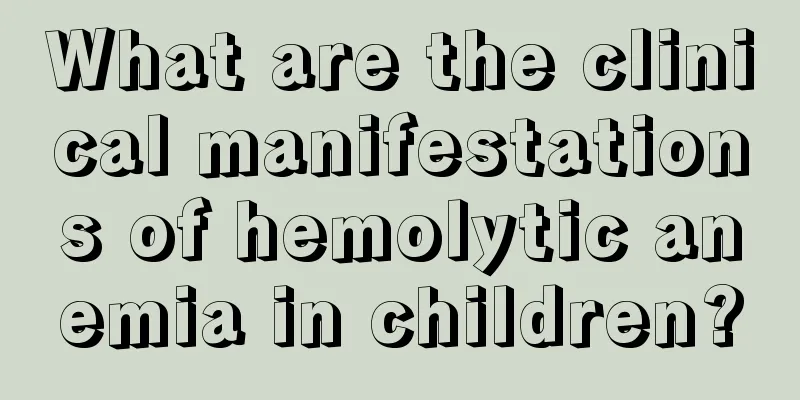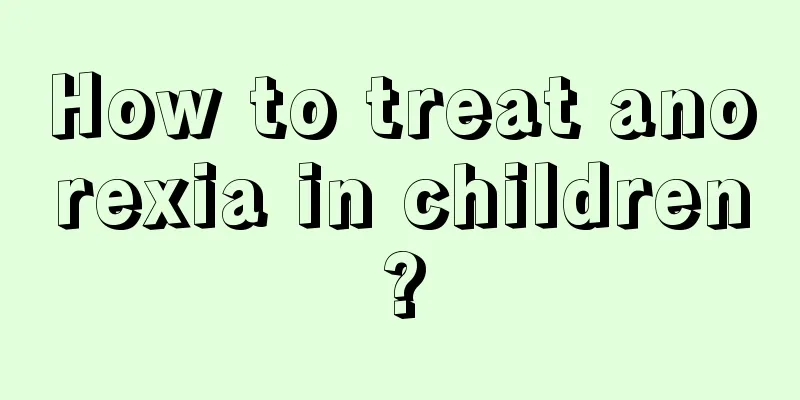What are the clinical manifestations of hemolytic anemia in children?

|
Nowadays, many common diseases include hemolytic anemia in children, and adults can clearly understand when they are sick. However, it is not easy for children to discover this, so parents need to understand this aspect well. However, many parents are often so busy with their work that they do not know much about these aspects, which delays their children's subsequent treatment. So, what are the clinical manifestations of hemolytic anemia in children? The clinical manifestations of neonatal hemolytic anemia are related to the time of hemolysis and the degree and speed of red blood cell destruction. In addition to anemia, there are also jaundice, edema and compensatory manifestations of the body. 1. Anemia: Mild hemolysis ( Moderate anemia may cause pale complexion and decreased hemoglobin ( Severe hemolysis may cause severe anemia in utero ( ⒉ Jaundice: Almost all children have varying degrees of jaundice and indirect hyperbilirubinemia, and in severe cases, kernicterus may occur. ⒊ Edema and giant placenta: Severe hemolytic anemia occurring in uterus may cause fetal edema and stillbirth. Infants with fetal edema have edema and paleness all over the body, and even cracked and water-oozing skin, accompanied by varying degrees of pleural effusion and ascites. In the most serious cases, the baby may die. The placenta may be normal in patients with mild hemolysis, but a giant placenta may be present in patients with severe hemolysis. ⒋ Enlargement of the liver and spleen: Enlargement of the liver and spleen is a manifestation of compensatory extramedullary hematopoiesis in the body of hemolytic anemia. The liver and spleen are obviously enlarged. Pathological examination of the dead fetus can reveal that the liver is enlarged and yellow-green, with a large number of piled immature red blood cells in the hepatic sinusoids and portal areas, the hepatocytes contain bilirubin and hemosiderin granules, the central cells of the lobule are fatty degenerated, the bile duct capillaries are dilated or contain bile thrombus; the spleen is significantly enlarged, with a large number of nucleated red blood cells and hemosiderin deposits, the splenic corpuscles are reduced or even disappeared, the splenic sinuses are enlarged, and the medulla is lace-like or spongy. ⒌ Hemolytic crisis: Generally speaking, the decrease in hemoglobin in neonatal hemolytic disease is progressive, but the magnitude of the decrease can be large or small. Most children with hereditary spherocytosis and erythrocyte G6PD deficiency show hyperbilirubinemia in the neonatal period. However, some children may suddenly experience acute hemolysis, a sudden drop in hemoglobin, a rapid increase in serum bilirubin, and other symptoms of hemolytic crisis such as irritability or lethargy, pale complexion, rapid heart rate, and rapid breathing. The crisis is caused by infection. People with G6PD deficiency may also be triggered by oxidative drugs. Due to massive hemolysis in a short period of time, serum bilirubin increases significantly, and the risk of bilirubin encephalopathy is high. ⒍Bilirubin encephalopathy: Bilirubin encephalopathy is a disease in which free bilirubin enters the central nervous system through the blood-brain barrier during neonatal hyperbilirubinemia, leading to poisoning and degeneration of nerve cells, and clinical and subclinical manifestations of abnormal nervous system, also known as kernicterus. ⑴ Severe bilirubin encephalopathy: Its clinical manifestations can be divided into 4 stages: ① Early stage, also known as the warning period: drowsiness, loss of sucking reflex, decreased muscle tone, or staring, blinking, and holding breath (mild cases); cerebral screaming and loss of hugging reflex (severe cases). This period lasts about 12 to 24 hours. Prompt treatment of hyperbilirubinemia can halt its progression. ② The middle stage, also known as the spasm stage: brief staring, eye rotation, downward eye movement, breath holding (mild symptoms); convulsions, opisthotonos and fever (80%), and DIC occurs. This period is the extremely critical period of the disease, lasting about 2 to 3 days, with a high mortality rate. If conditions permit, it is best to perform exchange transfusion therapy. ③ Late stage, that is, entering the recovery stage: Sucking ability is restored first. With the gradual consumption of antibodies in the body, hemolysis is reduced, jaundice subsides, acute phase symptoms disappear, eating becomes normal, and weight increases. This period lasts for 2 weeks. ④ Sequelae of kernicterus: Most children with kernicterus will have sequelae of varying degrees. Most of them will develop sequelae of kernicterus such as athetosis (100%) and enamel hypoplasia (75%) 2 to 3 months after birth; accompanied by convulsions, drooling, paralysis or intellectual development, etc. Patient rehabilitation treatment during this period is expected to lead to a certain degree of improvement. ⑵ Subclinical bilirubin encephalopathy: no clinical symptoms, only a subclinical state with abnormal brainstem auditory evoked potential (BAEP) and magnetic resonance imaging. The clinical manifestations of hemolytic anemia in children have been introduced in detail in the above content. I hope this can draw the attention of some parents and encourage them not to be so busy with their work that they neglect the healthy physical and mental development of their children. If you find the above symptoms, you must take your child to the hospital for examination and treatment in time so that he or she can recover as soon as possible. |
<<: Symptoms of renal hematuria in children
>>: How to supplement zinc and calcium deficiency in children
Recommend
What to do if your child has abdominal distension and vomiting
It is very common for children to have abdominal ...
What should babies with weak spleen and stomach eat?
The baby's body is relatively delicate. If th...
What is the treatment for pharyngitis in children?
Families don't want to see their children inv...
What should children eat to nourish their stomachs?
Children are a relatively special group. Every me...
What to do if your child's foot turns inward
It is very common for children to have inverted f...
What causes bone pain in children?
Children's bodies are relatively fragile. The...
The child has a stuffy nose and snores
The baby's body resistance is poor, and they ...
How to correct a child's hunchback
When children are in the growth and development p...
Precautions for children taking ascarid medicine
There are many precautions for children to take w...
Can children use cooling oil?
I believe many people have used cooling oil, whic...
Children with fever and vomiting
Since there are many reasons for children's f...
Why do children get sepsis?
Longdu is a very serious viral disease. This dise...
Symptoms of poor kidney function in babies
In our lives, many babies have poor kidney functi...
Is it normal for a 2 year old baby to drool?
It is a normal physiological phenomenon for babie...
Baby has a heavy nasal sound when sleeping
When many babies are sleeping, mothers will hear ...









